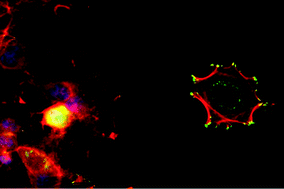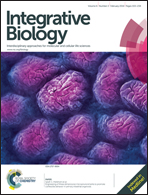Single cell gene expression analysis in injury-induced collective cell migration†
Abstract
Collective cell behavior in response to mechanical injury is central to various regenerative and pathological processes. Using a double-stranded locked nucleic acid probe for monitoring real-time intracellular gene expression, we examined the spatiotemporal response of epithelial cells during injury-induced collective migration and compared to the blocker assay with minimal injury as control. We showed that cells ∼150 μm from the wound edge exhibit a gradient in response to mechanical injury, expressing different genes depending on the wounding process. While release of contact inhibition is sufficient to trigger the migratory behavior, cell injury additionally induces reactive oxygen species, Nrf2 protein, and stress response genes, including heat shock protein 70 and heme oxygenase-1, in a spatiotemporal manner. Furthermore, we show that Nrf2 has an inhibitory role in injury-induced epithelial–mesenchymal transition, suggesting a potential autoregulatory mechanism in injury-induced response. Taken together, our single-cell gene expression analyses reveal modular cell responses to mechanical injury, manipulation of which may afford novel strategies for tissue repair and prevention of tumor invasion in the future.


 Please wait while we load your content...
Please wait while we load your content...